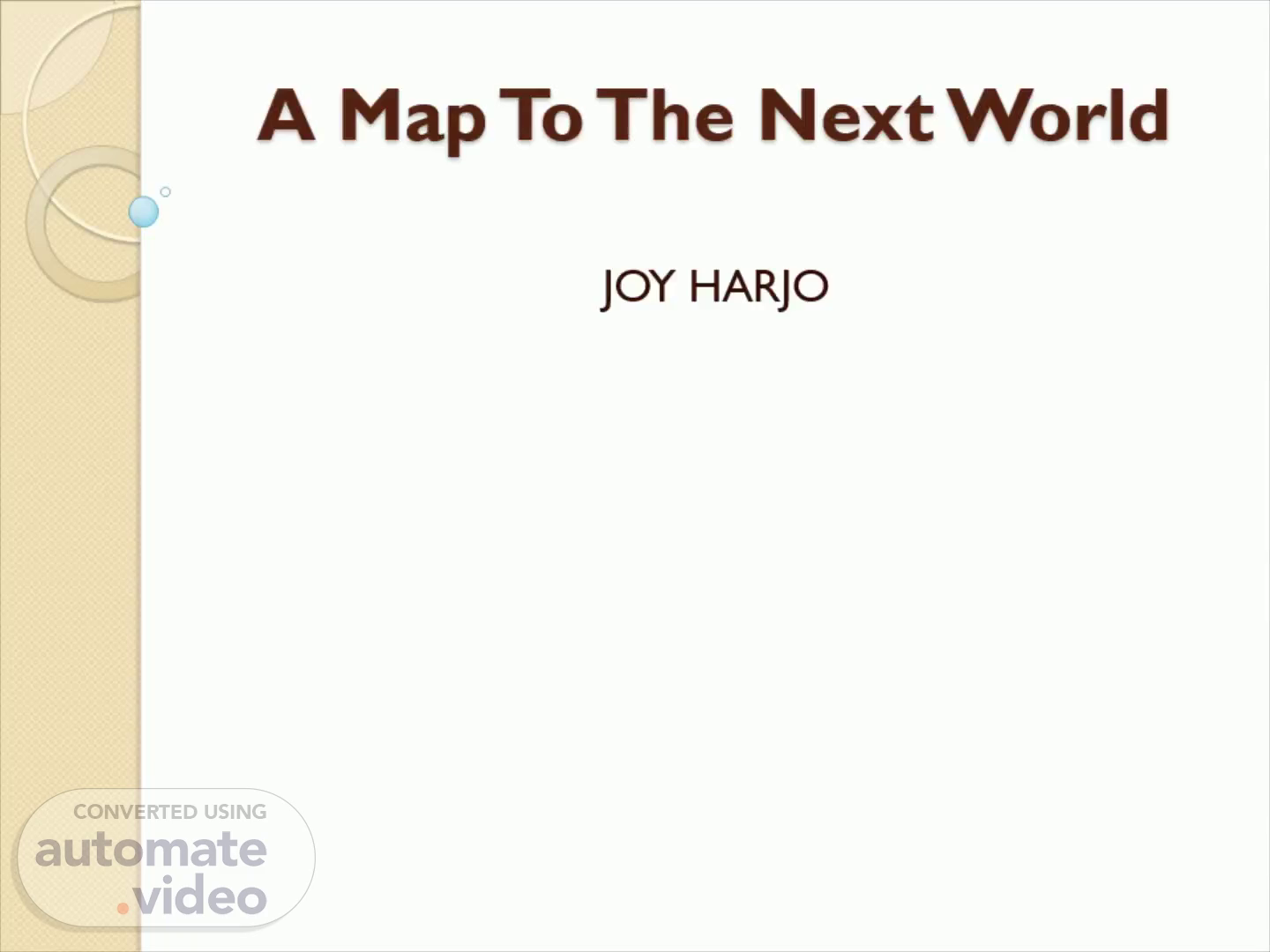
A Map To The Next World
Scene 1 (0s)
A Map To The Next World. JOY HARJO.
Scene 2 (7s)
A Map to the Next World” by Joy Harjo illustrates the fall of man and the birth of a better world. Symbolism about ancient civilization, modern day society, and her hopes for the future in her poem are used to emphasize that humanity should work towards a restored future. Harjo keeps referring to a map in her poem, but a map was not meant for the creator of that map to use. Maps are created for others to follow, usually to a goal that is desired..
Scene 3 (30s)
She is able to balance contemporary American life and ancient tribal truths magnificently. She is able to brilliantly attach the reader to the character. In “A Map to the Next World”, one knows that the poem is most probably addressed to a younger member of her family , a young daughter, or a grand daughter, in fact. But one feels that Harjo is personally talking to you – we are put in the shoes of a member of a kin..
Scene 4 (52s)
In this poem one can see how the idea of survival is central to the individual and the Native Americans as a people. And the way she addresses this survival is by emphasizing the importance of memory (a very central theme in Native American culture ) – how one should not forget one’s heritage..
Scene 5 (1m 8s)
The poem promotes an awareness and understanding of the strength of memory – a latch on the value on the powers of memory that all Native American cultures have. Moreover , one can see how survival and continuance are very strong bases for this poem..
Scene 6 (1m 22s)
There seems to be a sense of loss of land, love, innocence and heritage that escalates within. She discusses the importance of courage by alluding to many Native American spiritual tremors – “The place of entry is the sea of your mother’s blood, your father’s small death as he longs to know himself in another.” There has to be an understanding of the past for one to be able to move forward..
Scene 7 (1m 43s)
This discipline is central to many Native American cultures. In this case, Harjo alludes to her mother’s heritage (her blood), and how her father was lost in a sea of identities. “There is no exit.”, she says. One must have courage to survive. One must have courage to go on. One must have courage to be as tenacious as to venture out alone – to be able to trust oneself. “ The map can be interpreted through the wall of the intestine – a spiral on the road of Knowledge .”.
Scene 8 (2m 9s)
Coursing through survival and courage, Harjo moves in out of the realms of dream and reality. She focuses on both hope and despair, and survival and extinction at the same time. By showcasing these diverse strands of life, she is able to bring a harmonious balanced experience to the reader in the context of cultural allusions..
Scene 9 (2m 27s)
“You will travel through the membrane of death, smell cooking from the encampment where our relatives make a fest of fresh deer meat and corn soup, in the Milky Way .” In this passage, she focuses on the point that to survive this world, one must not forget. To go through life and remember, one must travel the way our forefathers did..
Scene 10 (2m 46s)
“Through the membrane of death” reminds one of the cultural belief in reincarnation – that through dying, one is born. “Encampment ... fresh deer meat” both paint the picture of a Native American village dinner – together around a fire, feasting on the day’s hunt..
Scene 11 (3m 1s)
This melding of dream visions, memories , myths and history promotes a centeredness in deep reverence for the natural world (a very Native American ideology), where one should find solace in one’s own heritage and mythology. But Harjo does not necessarily talk about her own heritage (Cherokee) alone, but includes other Native American tribal traditions..
Scene 12 (3m 18s)
There are snippets of other traditions which she brings in as a way to universalize experiences . In a way, she is striving to resolve polarities to bring the world into a balance through the awareness of the unspoken superiority one feels as a bearer of ancient culture. All one has to do is remember – “They have never left us; we abandoned them for science ”..
Scene 13 (3m 37s)
THANK YOU FOR YOUR PATIENCE LISTENING!.